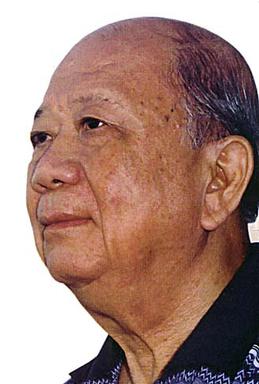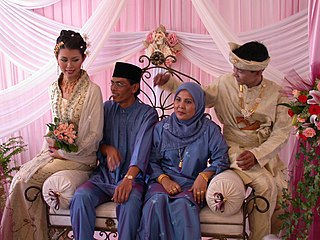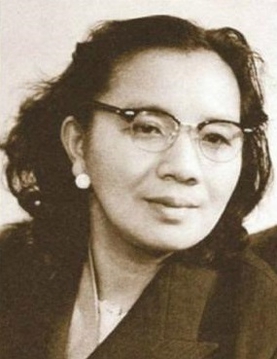
The Malayan Emergency, also known as the Anti–British National Liberation War(1948–1960), was a guerrilla war fought in British Malaya between communist pro-independence fighters of the Malayan National Liberation Army (MNLA) and the military forces of the Federation of Malaya, British Empire and Commonwealth. The communists fought to win independence for Malaya from the British Empire and to establish a socialist economy, while the Malayan Federation and Commonwealth forces fought to combat communism and protect British economic and colonial interests. The term "Emergency" was used by the British to characterise the conflict in order to avoid referring to it as a war, because London-based insurers would not pay out in instances of civil wars.

Orang Asli are a heterogeneous indigenous population forming a national minority in Malaysia. They are the oldest inhabitants of Peninsular Malaysia.

Chin Peng, born Ong Boon Hua, was a Malayan communist guerilla leader and politician, who was the long-time leader of the Malayan Communist Party (MCP) and the Malayan National Liberation Army (MNLA).

Malay Singaporeans are an umbrella term for the indigenous ethnic groups of Maritime Southeast Asia-origin who adhered to the religion of Islam and settled in Singapore. The Singaporean Malays constitute approximately 13.5% of the country's citizens, making them the second largest ethnic group in Singapore. Under the Constitution of Singapore, they are recognised by the government as the indigenous people of the country, with Malay as the ethnosocial language.

Jakunpeople or Orang Ulu/Orang Hulu are an ethnic group recognised as Orang Asli of the Malay Peninsula in Malaysia.

The Royal Ranger Regiment is an infantry regiment of the Malaysian Army. Although it is second in seniority to the Royal Malay Regiment, the RRD can trace its origins back to the mid 19th century and the establishment of The Sarawak Rangers, the peacekeeping force in the Sarawak region. This force was absorbed by the Sarawak Constabulary in 1932, but the name was revived in 1941 as a British Colonial unit; this unit commanded by British Lieutenant Colonel C.M. Lane was captured by the Japanese in 1942.

The Malayan Communist Party (MCP), officially the Communist Party of Malaya (CPM), was a Marxist–Leninist and anti-imperialist communist party which was active in British Malaya and later, the modern states of Malaysia and Singapore from 1930 to 1989. It was responsible for the creation of both the Malayan Peoples' Anti-Japanese Army and the Malayan National Liberation Army.

Bukit Kepong incident was an armed encounter in 1950 during the Malayan Emergency between the Federation of Malaya Police and the guerrillas of the Malayan National Liberation Army (MNLA), the armed wing of the Malayan Communist Party (MCP). This conflict took place in an area surrounding the Bukit Kepong police station in Bukit Kepong. The wooden station was located on the river banks of the Muar River, about 59 km from Muar town, Johor.

The Senoi Praaq is a unit of the Royal Malaysia Police made up almost entirely of the tribal people of Peninsular Malaysia known as the Orang Asli (aborigines). The name Senoi Praaq means war people or those who fight in the Semai language. Roy Davis Linville Jumper considered them one of the finest jungle fighting forces and was highly successful in diminishing the threat by communist forces during the Malayan Emergency.

The Malayan National Liberation Army (MNLA), often mistranslated as the Tentera Pembebasan Kebangsaan Malaya, was a communist guerrilla army that fought for Malayan independence from the British Empire during the Malayan Emergency (1948–1960) and later fought against the Malaysian government in the Communist insurgency in Malaysia (1968–1989). Their central committee was a trade union activist known as Chin Peng who had previously been awarded an OBE by the British for waging a guerrilla war against the Japanese occupation of Malaya. Many MNLA fighters were former members of the Malayan Peoples' Anti-Japanese Army (MPAJA) which had been previously trained and funded by the British to fight against Japan during the Second World War.

Rashid Maidin, sometimes given as Rashid Mahideen, was a senior leader of the Communist Party of Malaya (CPM).

The Communist insurgency in Malaysia, also known as the Second Malayan Emergency, was an armed conflict which occurred in Malaysia from 1968 to 1989, between the Malayan Communist Party (MCP) and Malaysian federal security forces.
Amir Muhammad is a Malaysian writer and independent filmmaker.

Shamsiah Fakeh was a Malaysian nationalist and feminist. She was the leader of Angkatan Wanita Sedar (AWAS), Malaysia's first nationalist women organisation and a prominent Malay leader of the Communist Party of Malaya (CPM). She was the grandmother of Jamaliah Jamaluddin, Member of the Selangor State Executive Council (EXCO) and Member of the Selangor State Legislative Assembly (MLA) for Bandar Utama.
Cik Dat bin Anjang Abdullah, commonly known as Abdullah CD, is a Malaysian former politician who served as chairman and General Secretary of the Communist Party of Malaya (CPM).

The General Operations Force is the light infantry arm of the Royal Malaysia Police. The General Operations Force was established in 1948 during the Malayan Emergency by the British Administration when Malaya was a colony. The police service was mobilised to the field role, primarily to engaging Communist guerrillas during the emerging Insurgency. When Malaysia was formed in 1963, this law enforcement unit was then known as the Police Field Force. The title was adopted when it dropped the previous handle widely referred to as the Jungle Squad.

The Temuan people are a Proto-Malay ethnic group indigenous to western parts of Peninsular Malaysia. They can be found in the states of Selangor, Pahang, Johor, Negeri Sembilan and Malacca. The Temuans are classified as part of Orang Asli group according to the Malaysian government. They are also one of the largest and the most widespread of the Orang Asli ethnic groups.

The Peace Agreement of Hat Yai (1989) marked the end of the Communist insurgency in Malaysia (1968–1989). It was signed and ratified by the Malayan Communist Party (MCP), and the Malaysian and Thailand governments at the Lee Gardens Hotel in Hat Yai, Thailand, on 2 December 1989.
Abu Samah Mohd Kassim was one of central committee member of the Malayan Communist Party during 1975. He was an important Malay communist in the 1970s.
The Malaysian Communist Party (MCP) was a merger of the Communist Party of Malaya/Marxist-Leninist (CPM-ML) and the Communist Party of Malaya/Revolutionary Faction (CPM-RF). Both factions split out from the Malayan Communist Party in the 1970s. MCP traced its roots to splinter groups amongst communist guerrillas in southern Thailand in the 1970s. The party conducted armed struggle in the Malaysian-Thai border areas between 1983 and 1987. The former CPM-RF members lay down their arms on 13 March 1987 and the former CPM-ML members lay down theirs on 28 April 1987. It eventually accepted a deal for cessation of hostilities with the Thai military and its cadres were resettled in 5 'friendship villages'.


















